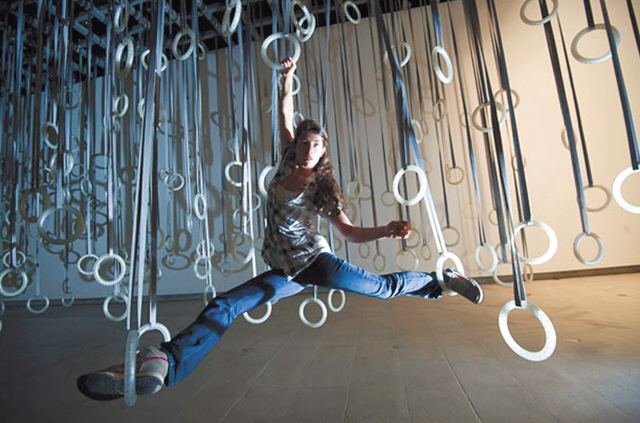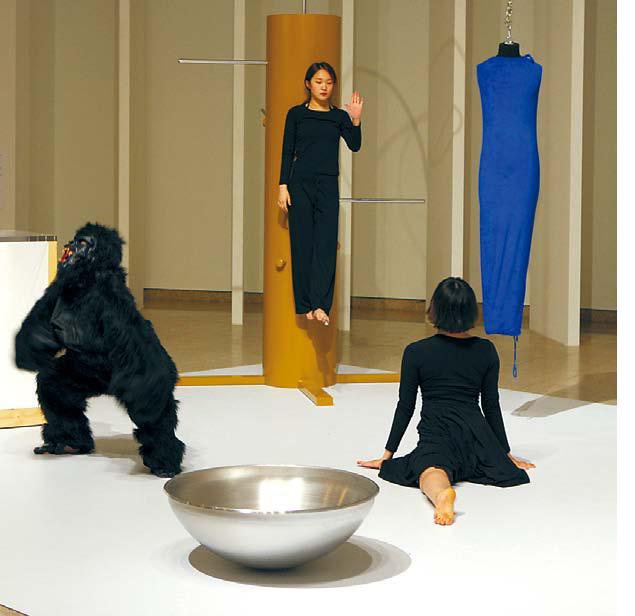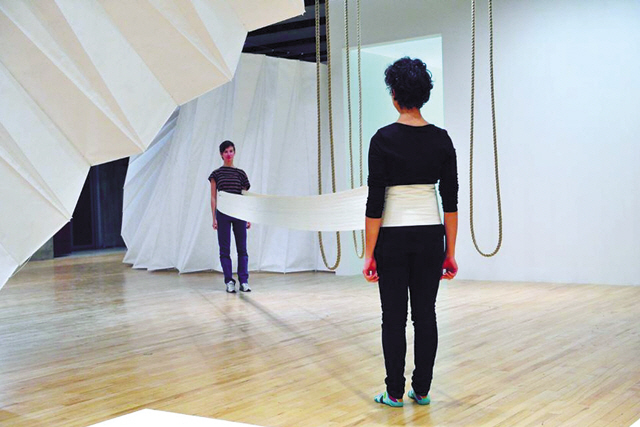Art meets dance: Exhibition brings viewers into the artwork
By Lee Woo-youngPublished : June 6, 2012 - 18:48
Viewers become part of exhibits, study their body and balance
An innovative exhibition is creating a rare scene in the Korean art world by combining art and dance.
At the exhibition titled “The Move: Art and Dance since the 1960s” at the National Museum of Contemporary Art of Korea, the artwork is not in a completed state until viewers engage with it physically.
For two months, the NMOCA will feature a dynamic exhibition featuring installations and sculptures complemented with live dance performances ― an approach started in the 1960s.
An innovative exhibition is creating a rare scene in the Korean art world by combining art and dance.
At the exhibition titled “The Move: Art and Dance since the 1960s” at the National Museum of Contemporary Art of Korea, the artwork is not in a completed state until viewers engage with it physically.
For two months, the NMOCA will feature a dynamic exhibition featuring installations and sculptures complemented with live dance performances ― an approach started in the 1960s.

“The exhibition explores how dance can be incorporated into the art world. It is also the best place where viewers can close their distance to artworks,” said the exhibition curator Lee Su-yeon.
The exhibition is a reinterpretation of showcases that drew much attention to the mix of art and dance at renowned galleries in England and Germany in 2010 and 2011.
With cooperation from Hayward Gallery in London, the exhibition welcomes visitors to a world where art and dance are hardly indistinguishable, with a hint of Korea added to it.
The “Magnificent Korean Arch in Traditional Colors” by Argentinean artist Pablo Bronstein features a solo performance by a dancer who dances around the red and green mini-architecture.
The audience can become an active participant and complete the artwork while raising awareness of their body through random movements in another piece. They can start by simply sitting in a chair or move in any way or direction in Spanish artist La Ribot’s work called “Walk the Chair.”


To find more meaning in their movement, viewers can try out German artist Franz Erhard Walther’s installation “Body Weights,” a long piece of fabric that wraps around two people who can counterbalance each other’s weight.
“Participants will feel the weight that the object gives to them by feeling awkward with a stranger and comfortable with friends and lovers,” said Lee.
A little more challenging is the see-saw by U.S. artist Robert Morris on which visitors must balance on a wooden plank. The artwork was first displayed at Tate Gallery in London in 1971.
What seems to be an innovative and new approach to art actually dates back to the late 1950s and ‘60s when artists began to explore integrating art and choreography. With the anti-war movement and emphasis on free-spirited motion, artists sought to explore a new approach.
This approach represents “an attitude shared by an entire generation of artists after the end of the Second World War, when different forms of art entered into an often seamless fusion,” wrote Stephanie Rosenthal, co-curator of the exhibition from the Hayward Gallery in London, in the exhibition essay.
The short performance for Bronstein’s work runs eight times a day. Other long performances are scheduled for twice a day.
To add fun to it, some performances are planned at random times during exhibition hours.
Performances will be ongoing from 2 p.m. to 6 p.m. on Fridays and Saturdays.
“The Move: Art and Dance since the 1960s” continues through Aug. 12 at the National Museum of Contemporary Art of Korea in Gwacheon.
For more information, call (02) 2188-6114 or visit www.moca.go.kr.
By Lee Woo-young (wylee@heraldcorp.com)







![[Graphic News] More Koreans say they plan long-distance trips this year](http://res.heraldm.com/phpwas/restmb_idxmake.php?idx=644&simg=/content/image/2024/04/17/20240417050828_0.gif&u=)
![[KH Explains] Hyundai's full hybrid edge to pay off amid slow transition to pure EVs](http://res.heraldm.com/phpwas/restmb_idxmake.php?idx=644&simg=/content/image/2024/04/18/20240418050645_0.jpg&u=20240419100350)





![[From the Scene] Monks, Buddhists hail return of remains of Buddhas](http://res.heraldm.com/phpwas/restmb_idxmake.php?idx=652&simg=/content/image/2024/04/19/20240419050617_0.jpg&u=20240419175937)

![[KH Explains] Hyundai's full hybrid edge to pay off amid slow transition to pure EVs](http://res.heraldm.com/phpwas/restmb_idxmake.php?idx=652&simg=/content/image/2024/04/18/20240418050645_0.jpg&u=20240419100350)

![[Today’s K-pop] Illit drops debut single remix](http://res.heraldm.com/phpwas/restmb_idxmake.php?idx=642&simg=/content/image/2024/04/19/20240419050612_0.jpg&u=)